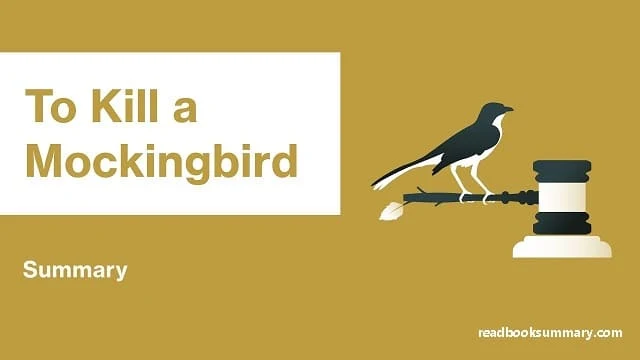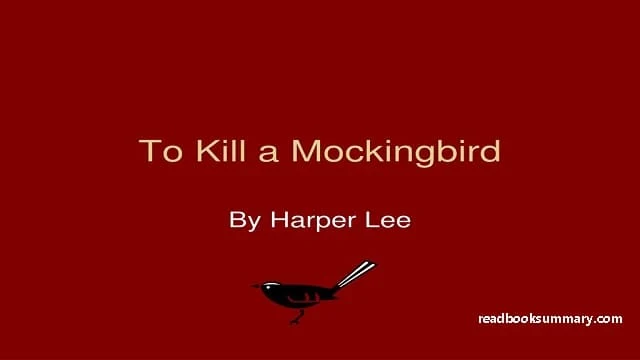To Kill a Mockingbird Summary. To Kill a Mockingbird Book is a novel by author Harper Lee. It was published in 1960 and was instantly successful. In the United States, it is widely read in high schools and middle schools. To Kill a Mockingbird has become a classic of modern American literature; a year after its release, it won the Pulitzer Prize.
To Kill a Mockingbird Book and characters are loosely based on Lee's observations of her family, her neighbors and an event that occurred near her hometown of Monroeville, Alabama, in 1936, when she was ten.
 |
| To Kill a Mockingbird Synopsis |
To Kill a Mockingbird Summary
Scout Finch lives with her brother, Jem, and their widowed father, Atticus, in the sleepy Alabama town of Maycomb. Maycomb is suffering through the Great Depression, but Atticus is a prominent lawyer and the Finch family is reasonably well off in comparison to the rest of society.
One summer, Jem and Scout befriend a boy named Dill, who has come to live in their neighborhood for the summer, and the trio acts out stories together. Eventually, Dill becomes fascinated with the spooky house on their street called the Radley Place. The house is owned by Mr. Nathan Radley, whose brother, Arthur (nicknamed Boo), has lived there for years without venturing outside.
Scout goes to school for the first time that fall and detests it. She and Jem find gifts apparently left for them in a knothole of a tree on the Radley property. Dill returns the following summer, and he, Scout, and Jem begin to act out the story of Boo Radley.
Atticus puts a stop to their antics, urging the children to try to see life from another person’s perspective before making judgments. But, on Dill’s last night in Maycomb for the summer, the three sneak onto the Radley property, where Nathan Radley shoots at them. Jem loses his pants in the ensuing escape. When he returns for them, he finds them mended and hung over the fence.
The next winter, Jem and Scout find more presents in the tree, presumably left by the mysterious Boo. Nathan Radley eventually plugs the knothole with cement. Shortly thereafter, a fire breaks out in another neighbor’s house, and during the fire someone slips a blanket on Scout’s shoulders as she watches the blaze. Convinced that Boo did it, Jem tells Atticus about the mended pants and the presents.
To the consternation of Maycomb’s racist white community, Atticus agrees to defend a Black man named Tom Robinson, who has been accused of raping a white woman. Because of Atticus’s decision, Jem and Scout are subjected to abuse from other children, even when they celebrate Christmas at the family compound on Finch’s Landing. Calpurnia, the Finches’ Black cook, takes them to the local Black church, where the warm and close-knit community largely embraces the children.
Atticus’s sister, Alexandra, comes to live with the Finches the next summer. Dill, who is supposed to live with his “new father” in another town, runs away and comes to Maycomb. Tom Robinson’s trial begins, and when the accused man is placed in the local jail, a mob gathers to lynch him. Atticus faces the mob down the night before the trial. Jem and Scout, who have sneaked out of the house, soon join him. Scout recognizes one of the men, and her polite questioning about his son shames him into dispersing the mob.
At the trial itself, the children sit in the “colored balcony” with the town’s Black citizens. Atticus provides clear evidence that the accusers, Mayella Ewell and her father, Bob, are lying: in fact, Mayella propositioned Tom Robinson, was caught by her father, and then accused Tom of rape to cover her shame and guilt.
Atticus provides impressive evidence that the marks on Mayella’s face are from wounds that her father inflicted; upon discovering her with Tom, he called her a whore and beat her. Yet, despite the significant evidence pointing to Tom’s innocence, the all-white jury convicts him. The innocent Tom later tries to escape from prison and is shot to death. In the aftermath of the trial, Jem’s faith in justice is badly shaken, and he lapses into despondency and doubt.
Despite the verdict, Bob Ewell feels that Atticus and the judge have made a fool out of him, and he vows revenge. He menaces Tom Robinson’s widow, tries to break into the judge’s house, and finally attacks Jem and Scout as they walk home from a Halloween party. Boo Radley intervenes, however, saving the children and stabbing Ewell fatally during the struggle. Boo carries the wounded Jem back to Atticus’s house, where the sheriff, in order to protect Boo, insists that Ewell tripped over a tree root and fell on his own knife. After sitting with Scout for a while, Boo disappears once more into the Radley house.
Later, Scout feels as though she can finally imagine what life is like for Boo. He has become a human being to her at last. With this realization, Scout embraces her father’s advice to practice sympathy and understanding and demonstrates that her experiences with hatred and prejudice will not sully her faith in human goodness.
You may also like to read: The Subtle Art of not Giving AF summary
To Kill a Mockingbird Themes
Racial Injustice and Prejudice: The novel confronts the ugly reality of racism in the American South, exposing the deep-seated prejudice faced by Black people like Tom Robinson, Through Scout's naive perspective, we witness the hypocrisy and cruelty of a society that judges individuals based solely on the color of their skin, However, the novel also offers glimmers of hope and compassion, highlighting the importance of empathy and understanding in challenging ingrained biases.
Courage and Morality: Atticus Finch, Scout's father, embodies unwavering courage and moral conviction in the face of adversity, He defends Tom Robinson despite knowing the prejudice he will face, demonstrating the power of standing up for what is right even when it is difficult, The novel encourages readers to confront their own prejudices and act with courage in the face of injustice.
Loss of Innocence and Coming of Age: Scout's journey throughout the novel is one of losing her childhood innocence and confronting the harsh realities of the adult world, Through her experiences, she learns valuable lessons about empathy, compassion, and the importance of fighting for what is right, To Kill a Mockingbird serves as a poignant coming-of-age story, reminding us of the transformative power of facing difficult truths and growing in understanding.
Importance of Perspective and Empathy: The novel emphasizes the importance of seeing the world through the eyes of others and developing empathy for those different from ourselves, Scout's journey is marked by her growing understanding of Boo Radley, a misunderstood neighbor ostracized by the community, Through Scout's evolving perspective, we learn the importance of challenging assumptions and judging individuals based on their actions and character, not stereotypes or preconceived notions.
Hope and Resilience: Despite the darkness and injustice it depicts, To Kill a Mockingbird ultimately offers a message of hope and resilience, Scout's unwavering faith in her father and her growing understanding of the world provide a glimmer of hope for a future where compassion and justice prevail, The novel reminds us that even in the face of adversity, there is always room for growth, understanding, and positive change.
You may also like to read: To Kill a Mockingbird Quotes
 |
| to kill a mockingbird plot Summary |
 |
| To Kill a Mockingbird Chapter Summary |
Questions and Answers about To Kill a Mockingbird Plot
What is the main summary of To Kill A Mockingbird? To Kill a Mockingbird is both a young girl's coming-of-age story and a darker drama about the roots and consequences of racism and prejudice, probing how good and evil can coexist within a single community or individual.
Why is To Kill A Mockingbird so important? To Kill a Mockingbird is an important book for any Chicagoan and any American to read because it is a keen reminder of prejudices that can exist in society and the detriment they pose to communities.
What is the famous quote from To Kill A Mockingbird? “Shoot all the bluejays you want, if you can hit 'em, but remember it's a sin to kill a mockingbird.”
What are the 3 main themes of To Kill A Mockingbird? Three main themes include:
- prejudice.
- family life.
- courage.
What does To Kill a Mockingbird teach us? It tells us about racial prejudice and the impact of race and class in the American Deep South. Ultimately it is a story of humanity and the need for justice in society. It teaches about the weigh of racism and how it affects each and every aspect of life.
What is one lesson of To Kill a Mockingbird? Protect the innocent: Of course, no list of lessons from To Kill a Mockingbird would be complete without the famous line that gave the novel its title! It's a beautiful reminder that hurting the innocent is the worst crime of all.
Is To Kill a Mockingbird a good story? To Kill a Mockingbird one of the best-loved stories of all time, is a novel by Harper Lee published in 1960. It was immediately successful, winning the Pulitzer Prize, and has become a classic of modern American literature.
Why is To Kill a Mockingbird a banned book? After a mother complained to the superintendent that her son was uncomfortable with the N-word, the novel was removed from the 8th-grade curriculum at Biloxi (MS) Public Schools in the middle of teaching it, without following policy.
Why do people love To Kill a Mockingbird? To Kill a Mockingbird focuses on the gut instinct of right and wrong. It distinguishes it wonderfully from just following the law of the land, a battle that ensues through the ages. Atticus Finch's messages are all the more relevant in the current times as the book is meaningful in every period, including today.
What does a mockingbird symbolize? In this story of innocence destroyed by evil, the 'mockingbird' comes to represent the idea of innocence. Thus, to kill a mockingbird is to destroy innocence."
What is the most important message in To Kill a Mockingbird? The most important theme of To Kill a Mockingbird is the book's exploration of the moral nature of human beings—that is, whether people are essentially good or essentially evil.
How does To Kill a Mockingbird end? The novel ends after Bob Ewell attacks Scout and Jem, and Boo Radley rescues them, killing Bob in the process. Atticus and Sheriff Heck Tate have a conversation about how to deal with the situation, and Scout walks Boo home.
Why is it called To Kill a Mockingbird? Mockingbirds, The title of To Kill a Mockingbird has very little literal connection to the plot, but it carries a great deal of symbolic weight in the book. In this story of innocents destroyed by evil, the “mockingbird” comes to represent the idea of innocence. Thus, to kill a mockingbird is to destroy innocence.
